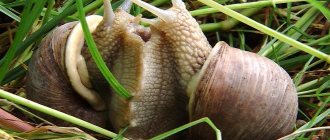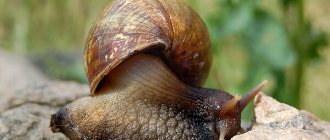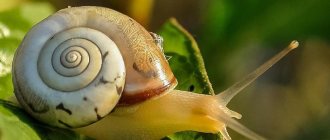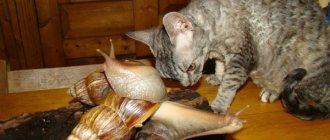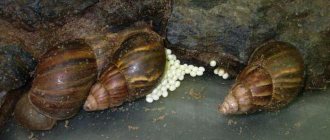Domestic land snails, especially the giant African Achatina, have long been transformed from exotic representatives of the fauna into cute pets, which are often kept in ordinary city apartments. No less popular are aquarium mollusks, which you can watch with interest for hours. These pets are unpretentious in everyday life and reproduce in almost any conditions, but they are quite demanding in terms of nutrition and are even able to refuse food of poor quality. Therefore, future owners need to collect as much information as possible about what they can feed their domestic snails.
Description
The grape snail has an elastic, movable body and a hard, static shell.
The diameter of the latter is from 3.5 to 5 cm. This is quite enough for the body to completely fit in the spirally twisted “house”. The color of the shell is heterogeneous, consisting of light and dark stripes. Color varies from chestnut-white to yellowish-olive. The surface of the shell is ribbed.
The body of the grape snail, like that of other mollusks, is very elastic and can change size from 3 to 10 cm. It is painted beige or gray with a brown tint. The surface of the body is rough, wrinkled, designed to retain moisture.
The color of the body can change depending on the food consumed by the mollusk.
There are 4 movable tentacles on the head that play the role of sensory organs. The front ones perform a tactile function, the rear ones perform a visual function.
Shellfish in cooking
Shellfish and their caviar have long been used in cooking by chefs in many countries. The grape snail is a real exotic edible delicacy of French cuisine. For serving, restaurants use various sauces: garlic, cream, white wine and others. Serve large ones directly in the shells (without opening) along with onions and herbs. Small snails are used as a minor ingredient in soups and many main courses, such as stews or potatoes.
How many dishes to prepare? There are many recipes, as already noted. Grape snails can be fried in oil in a frying pan or in a slow cooker, baked in the oven, or boiled on the stove. Shellfish are marinated for a special barbecue, and also stuffed and canned.
Marinated, boiled, fried, baked snails make delicious salads, snacks for beer and other drinks, which are favored by all gourmets.
Habitat in nature
Under natural conditions, snails live in green meadows, forests with thick grass and sparse trees, or in gardens.
They prefer areas with limestone or chalky soil that is naturally alkaline. Cold-blooded creatures wait out dry periods by hiding under boulders, in damp moss or thick grass. For the winter they go into suspended animation, climbing inside the shell. The snails close the entrance to it with mucus.
The use of snails in cosmetology
The use of snails in cosmetology is quite widespread. Shellfish mucus contains a large amount of natural antioxidants. That is why this extract is of great importance, being the basis for the manufacture of many cosmetic preparations, the effect of which is aimed at rejuvenating the skin of the face. Special balms, creams, lotions, masks and tonics containing snail mucus have long been used in many countries around the world.
Some beauty salons include treatments that include facial massages using snails. In addition to the fact that it is very pleasant, the mollusk leaves its mucus on the face, which heals minor damage to the skin after procedures, for example, after peeling. Elephant masters first cleanse the skin with special products, and then place a large snail on the face. The mollusk crawls for 15-20 minutes, then the cosmetologist removes it, rinses the skin and applies cream. It is worth noting that the price for these procedures, which, by the way, are in demand, is not so low, but the reviews are extremely positive. For these purposes, snails are specially prepared.
The optimal solution to the problem and cheaper in cost is the process of preparing an anti-aging mask with your own hands at home. This can be done if you breed snails at home or keep them as a pet. In this case, in the morning you can easily collect the mucus in the terrarium and prepare the necessary remedy. Pour 0.5 teaspoon of mucus with 2 teaspoons of water at room temperature, stir thoroughly so that the secretion is completely dissolved in the liquid, add 1 teaspoon of cosmetic clay (green or blue), stir the composition again. Wash your face with a special cleanser and only then apply a mucus mask to your face. Keep it on for 20 minutes and then rinse with water.
To achieve results, you need to regularly carry out procedures with snails. Apply a mollusk mucus mask several times a week and notice the effect within a month: wrinkles will disappear, the skin will be soft, tender, smooth, velvety and acquire an even color tone.
Purchasing a grape snail
These mollusks are quite well distributed throughout Europe and acquiring them is not difficult. You can buy grape snails at a pet store, order them online, or look for them in private advertisements. In some regions, these animals can simply be collected from the garden.
The cost of a grape snail is not very high, it can vary from 50 to 350 rubles . The price depends on the region and size of the individual. Wholesale purchase will be even cheaper - 6-8 dollars per kilogram.
A user talks about his experience of keeping a snail at home
>
Mr. Tail Recommends: Natural Habitat
The native habitat of grape snails is open areas of deciduous or mixed plantings, parks, gardens, vineyards, and forests. The soils in such areas are usually alkaline.
In hot weather with minimal humidity, mollusks hide under stones, among the roots of bushes and trees, and burrow into moss and fallen leaves. Stress for them is excessively high and low temperature changes.
In the summer, before sunrise, the snail sticks to the back of a leaf of a tree or bush, which allows it to easily survive the heat of the day.
If a mollusk crawls, it leaves a characteristic slimy trail behind it. This composition protects it, protecting the delicate body from damage.
The birthplace of these creatures of nature is most likely the central and southeastern parts of Europe.
Now the habitat of gastropods of this type has expanded - this is all of Europe (except for the cold northern regions) and the Baltic coast, Australia and southern Russia.
Photo gallery of grape snail:
Reproduction and breeding
Grape snails are hermaphrodites, so any individual that has reached sexual maturity can mate.
In nature, the desire to reproduce usually appears in them in the spring under very certain climatic conditions. It is not difficult to recognize an excited individual looking for a partner. The mollusk crawls restlessly, periodically stopping and raising its upper body. He looks around and moves the horns on his head in search of a suitable “friend.”
Having finally found a mating partner, the snail begins a slow, intimate “dance.” The mollusks are pressed tightly with their soles, intertwined with tentacles and touching the genitals that emerge from the body. After this, the mating process itself begins, which lasts over 1.5 hours. At the peak of excitement, the partners exchange male cells, then separate and go about their business.
To stimulate the breeding process, it is necessary to create favorable conditions for this. Then the snails will mate even in the fall.
- The temperature must be maintained within 16–23°;
- air humidity is from 80 to 90%, soil humidity is about 80%.
In general, snail breeding is not a difficult task, accessible even to a novice hobbyist.
A story about breeding grape snails in the country
Disease Prevention
There are several basic ways to prevent potential diseases:
- Maintain cleanliness in the toilet. This will minimize the risk of infection of the grape snail with parasites and pathogenic microflora;
- monitor your diet – its balance and variety;
- create the most comfortable living conditions - light, humidity, temperature.
In natural conditions, sexually mature individuals can live up to 9-10 years, in domestic conditions - up to 15 years. The oldest mollusk kept in artificial conditions was 35 years old at the time of death.
Laying eggs
Mollusks begin to lay offspring no earlier than 20–30 days after mating. They first prepare the nest by digging a suitable sized hole in the ground. Having carefully compacted the walls and bottom, the parent lays 30 to 40 eggs in the hole. Outwardly, they look like pearls - just as round, white and shiny. Having finished throwing offspring, the snail fills the hole with the eggs with soil.
The babies hatch from the soft shell and begin to dig their way out. After 9–11 days, they are safely released, feeding on the remains of their own shells and soil along the way.
Young snails, when fed abundantly, increase in size in record time. After 30 days they become 4 times larger than at birth. You can feed them the same as adults. The growing process is no different from keeping mature mollusks.
Benefits and harms
The grape snail has both benefits and harms on the human body, and this is no longer a secret, but a proven fact.
If we talk about beneficial properties, they are due to the composition of snails. The meat of these mollusks contains vitamins of groups A, B, K and PP, which improve vision, strengthen the immune system, and also normalize the functioning of the human nervous system, so these gastropods must be eaten.
Regarding the micro- and macroelements that are part of grape snails, these are potassium, magnesium, copper, phosphorus. These shellfish contain slightly less iron, calcium, selenium and zinc.
It also contains amino acids, including choline, which has a positive effect on brain activity.
Interesting fact! A lot of experiments were carried out, after which scientists came to the conclusion: neurons of gastropods easily take root in the human brain. Therefore, thanks to the medicinal properties of grape mollusks, it is possible to cure epilepsy and relieve other serious diseases of this kind. Snails are excellent donors.
The calorie content of shellfish as an independent dish is low: 100 grams of the product contains only 90 kilocalories. For this reason, the grape snail is considered not only an exotic delicacy with an unforgettable taste, but also a dietary product, and therefore you should not be afraid to gain a couple of extra pounds, but feel free to eat it. Doctors also recommend eating for people with disorders of the normal functioning of the gastrointestinal tract, with vision problems, and also to stabilize the functioning of the musculoskeletal system. In addition, it has been known since ancient times that snails have medicinal properties, which manifest themselves in the ability to cope with respiratory diseases, namely, they fight bronchitis, whooping cough and silicosis.
Shellfish meat also contains many biologically active substances, for example, alontoin, collagen, elastin, which are natural antibiotics that resist viruses, bacteria and other infectious diseases, and therefore it is really recommended to eat them.
Grape snails are rich in protein. There is many times more of it than in chicken eggs. And if you take into account the advice of doctors, snail meat is more dietary than chicken breasts, so it can be eaten by pregnant women and nursing mothers.
The mucus of mollusks also contains substances, thanks to which wounds and burns heal quickly if they are treated in time with the liquid secreted by the snails.
In addition to its benefits, the grape snail can cause harm to the human body if eaten in unlimited quantities. It is contraindicated to eat these shellfish for people with protein allergies, gout, or those with joint diseases. Proteins cause lactic acid to accumulate in the joints, which increases pain.
Nutrition
The vine snail is considered a pest of garden plants, which it eats in large quantities, causing significant damage.
Feeding her is not difficult at all. Pets should be given fresh fruits and vegetables, herbs and weeds. You can include beets, pumpkin, carrots, zucchini, lettuce, cabbage, apples, potatoes, bananas, strawberry leaves, dandelion, grapes, nettles, burdock, and horse chestnut in the clam's diet. Soaked bread, dried bloodworms and daphnia are often used as additional additives.
Clams require large amounts of calcium to form their shells. Therefore, they need to be given chalk or sepia (pieces of cuttlefish shell).
All products must first be cut into small pieces or slices to make it easier for the snails to eat.
You should not put a lot of food in a bowl, because a small creature needs just a little bit to eat.
Food can be given in the evening and leftovers removed in the morning.
Grape snail at home Video
List of prohibited products:
- Radish;
- boiled eggs;
- any citrus fruits;
- onion;
- radish;
- fried and spicy foods;
- cheese and cottage cheese;
- flour products.
Owner reviews
Recently, it has become fashionable to keep various unusual pets at home, such as grape snails, which in nature parasitize various living plants, causing them significant harm. Being in captivity, such a mollusk can eat all kinds of vegetation, fruits and vegetables.
Interesting moment! There are no problems in terms of feeding a grape snail kept at home. They eat almost everything: bananas, pears, apples, pumpkins, carrots, cabbage, potatoes, etc.
Home care practice shows that drafts or strong winds can harm the snail, as they accelerate moisture loss. Despite this, excess humidity in their home negatively affects their life expectancy, since snails breathe air. The most optimal humidity level is about 80 percent. If you follow all the rules of care, then snails are little susceptible to negative influences. Basically, snails suffer from high temperatures or hypothermia, which is associated with violations of living conditions. One should also take into account the fact that low temperatures negatively affect the development and growth of these mollusks, inhibiting these processes. In case of overheating, the snails can be sprayed with cold water, and in case of hypothermia - with warm water, or the snails can be rubbed down, either cold or warm.
It is not recommended to keep snails that are different species together. Individuals who have reached one or one and a half years of age take part in the reproduction process. Grape snails feel great at home. You can pick them up and bathe them in this position. Since the mollusk does not require special care, they can be kept by people who do not have much free time, and in general their maintenance can be entrusted to children.
Home improvement
A glass or plastic container is suitable as a terrarium for breeding and maintenance. It may be short, but with a wide bottom. It is advisable to use a container with a lid to prevent pets from crawling out.
Ventilation
To breathe, the snail needs normal atmospheric air. The mollusk breathes very rarely - no more than 1 breath per minute at medium humidity and even less often at high humidity. However, ventilation holes are a must! You can make a mesh lid or slots in the walls.
Temperature
To maintain normal life activity and stimulate reproduction, a temperature ranging from 15 to 25° is needed. Optimal content is at 19–22°. When the air temperature drops to 11°, snail activity decreases and growth stops. At an increase above 26°, the mollusks fall into suspended animation.
Lighting
Regular natural light is sufficient for grape snails; they do not require additional lighting. The terrarium should be positioned so that it is not exposed to direct sunlight.
Bottom
Snails in nature spend a lot of time in the ground. Here they rest, lay eggs, and hibernate. In the terrarium, it is also necessary to fill the bottom with a suitable substrate. To do this, you can use a mixture of garden soil and crushed activated carbon in a ratio of 7:1. You can also use shellfish shavings from a pet store or live moss as bedding.
The bedding in the terrarium should always be slightly damp, but not damp. It is enough to spray it with a spray bottle once every 1-2 days.
Water
If you want to create ideal living conditions for your pet, place a small pond with clean water in the terrarium. Do not make it deep so that living creatures cannot drown and get out of it on their own. You can simply put a plastic lid filled with cool water.
Scenery
There should be no sharp or hard objects in the terrarium that could cause mollusks to injure their delicate soles or shells. But live plants, pieces of bark and small twigs will come in very handy.
Snail farm
Grapes, like representatives of the related species Helix aspersa maxima, are bred on farms in large quantities. The site is prepared for the farm: trees are removed and the land is treated to remove pests. The land area reaches 300,000 square meters. m. The territory is fenced with a fence, the underground part of the fence is placed 0.5 m deep. Under the influence of natural conditions, mollusks hibernate and receive food and moisture. In extreme cold, animals are covered with film to prevent them from freezing. When the grape snails reach their maximum size, they are prepared for transportation.
Mode
Grape snails are active only at night. During the day they sleep, hiding in their house, and at night they eat and walk. When you approach the terrarium in the morning, you can find a dug up substrate, food remains, and mucous stains on the walls.
In addition to daytime sleep, long-term suspended animation is very important for snails. In nature, it begins with a strong increase in air temperature, the onset of cold weather or drought. At home, such conditions will have to be created artificially to stimulate the onset of hibernation. Otherwise, the mollusks will begin to wither and get sick, their lifespan will be shortened, and growing and maintaining them will become problematic.
Experienced shellfish breeders use 2 approaches:
- Temporal. The change in activity and suspended animation of creatures takes place according to a clearly defined schedule. For example, a pet stays awake for three weeks and falls into a long sleep for a week.
- Natural. The terrarium simulates the same conditions as outside. During rainy periods we increase the humidity, on dry days we create dryness, and when it gets cold we lower the temperature.
You can choose any of the two approaches and follow it all the time.
Terrarium and its cleaning
Requirements for the utilitarian
What parameters should you pay attention to first:
- volumes;
- lighting;
- transparency;
- temperature and humidity.
The best option is a spacious terrarium or aquarium, made of glass or plastic and with good ventilation. Since the pet crawls everywhere, it will easily move outside the open house. Therefore, you will definitely need a lid, preferably a mesh one. It will provide the necessary ventilation. In this case, the coating must have fastenings and fixation.
Interesting Facts
- The movement speed of grape snails is on average 3-4 mm per second. The maximum fixed speed is 7 mm.
- Mollusks can move freely not only on horizontal planes, but also on vertical ones.
- A video of snails mating gets about a million views on the Internet.
- Snail meat contains a balanced amount of BJU, as well as vitamins and microelements.
- The grape snail was the symbol of one of the communes in Switzerland. She is depicted on the coat of arms of this institution.
- From the body you can prepare helicidin, a medicinal extract with bronchodilator properties.
- The average lifespan of these creatures is 7-9 years. However, there are cases where a grape snail at home lived to be 17, 19 and 21 years old.
- 95% of grape snails die before reaching sexual maturity.
- The blood of mollusks is completely colorless.
- Grape snails began to be bred for food in the first century AD.
Adviсe
- Do not wash shellfish in tap water, as the liquid contains impurities and chlorine.
- Fill the bathing bowl with cooled boiled or settled water.
- If the shell breaks down and looks shabby, then there is little calcium in the diet. If this element is lacking, the snails also scrape each other’s shells with their teeth.
- Don't keep your pets in a cardboard "house". Cardboard is not moisture-resistant; a snail can gnaw a hole in such a tank and crawl away.
- If you do not need offspring, but several grape snails are kept together, remove and freeze the eggs in time.
The good thing about snails is that they are silent, do not take up much space, do not cause allergies, and are interesting to watch. The grape snail, unlike Achatina, can be found on the street and brought home. It is important that the individual looks healthy and that the shell is intact.
Previous
InhabitantsTurtle from the Red Book - European swamp
Next
InhabitantsSecrets of nutrition of aquatic and land turtles
Lifestyle and habitat
The spread of gastropods occurred throughout almost all of Europe. Valleys, lawns, edges, overgrown ravines, city parks, gardens are a comfortable habitat for these unpretentious creatures.
The active state of grape snails lasts from the first sunny days of spring until the autumn cold. Seasonal wakefulness of mollusks does not exceed 5 months. Moisture-loving animals are often found among stones, in the shade of bushes, and burrow into damp moss.
During the day, during dry times, they are motionless, hiding in places where moisture is better preserved. They sit in shells covered with a thin film to prevent evaporation. As if glued to trunks or branches, they wait out the midday heat. Heat, like cold, numbs snails.
Night time and damp weather awaken snails to search for food. The mollusk gets out of its hiding place and hits the road. The muscular leg carries the cochlea due to muscle contraction and secreted mucus, which softens friction.
The surface on which the mollusk crawls can be horizontal, vertical, or located at any angle. The grape snail pushes off from the support and glides at a speed of up to 7 cm per minute.
There are many natural enemies of the snail. It is a delicacy for all reptiles, hedgehogs, and moles. Some beetles crawl inside the mollusk through the breathing hole. With the arrival of autumn cold, the snail buries itself in the ground with its mouth raised for hibernation.
This arrangement protects against bacteria, retains a small layer of air, and allows you to quickly get out of the shelter in high water. The period of suspended animation lasts approximately 3 months. The animal digs a hole with its muscular leg. Depending on the density of the soil, the dug channel reaches 6 - 30 cm. If the rocky soil does not give way, the snail finds refuge under the autumn leaves.
The mollusk covers the mouth of the shell with a special mucous veil. After hardening, the lime layer becomes a reliable lid. The thickness of the cork varies, depending on the severity of the winter. Air enters through a small hole.
You can notice gas exchange by bubbles when the mollusk is immersed in water. Gastropods spend the wintering period alone, but sometimes gather in entire colonies. During wintering, the grape snail loses up to 10% of its weight.
In the spring, after awakening, the recovery period begins. Animal lovers are engaged in keeping and breeding shellfish. Although there are bans on their import into certain countries, interest in snails does not fade.
Variety of garden snails
The most common land gastropods are garden snails (common snails). The most famous types of garden snails will be described below.
Grape snail. Age can reach 8 years or more. The period of its activity lasts from spring until the onset of frost, after which the mollusk goes into hibernation. The main diet of the vineyard is plant food. And you can meet a representative of this species in the grass, on bushes, trees, and grape leaves.
The common amberfish has a translucent shell resembling an amber one. It lives in damp areas. May be in water. The lifespan of this mollusk is short: 13 – 17 months.
Chains are large representatives of the species. The shells of such mollusks measure 16 by 20 mm, and the head and legs of some of their species are translucent. Active deforestation and increased interest among collectors in the shells of such snails have brought their population to the brink of survival, so in many countries they are protected by law.
The woody variety is distinguished by a spherical shell and smoothed curls. Its color can vary from light yellow to dark brown with small spots and streaks.
The shiny snail is a steppe species of mollusks that live in dry meadows, forest edges and bushes. The shell has a spherical shape and four curls. The color is white or slightly yellowish.
The bush snail is distinguished by a large rounded shell, the color of which can be gray, red-brown or even blue-black. Its natural habitat is wet forest edges, meadows, and fields. The mollusk's diet is exclusively plant-based and it enters hibernation in October.
Cepaea sylvatica of the chain genus is the rarest garden snail. She lives in the northern and central part of the European continent. In Russia, these mollusks are found in the Kaliningrad and Leningrad regions. At the same time, they prefer warm, sun-warmed places. The diet of this mollusk contains lichen, detritus, and some types of mushrooms. She lays eggs in the ground.
Cooking at home
Cooking grape snails at home is not particularly difficult, but the result will appeal to all gourmets. There are countless recipes, for example, Burgundian, Korean, Chinese, however, shellfish have their own characteristics, which must be adhered to during cooking so that the dish turns out not only tasty, but also healthy.
Today, grape snails are freely available for sale. They can be purchased fresh or frozen.
To properly prepare shellfish with your own hands at home, you need to follow these recommendations:
- Live snails must be “disinfected” before cooking, since they feed on substances that are toxic to humans. Therefore, after catching mollusks, they need to be planted in a special container, cared for, but fed exclusively with flour for 10 days. After the specified time has passed, they need to be covered with salt in order to get rid of harmful substances. This will also lead to the death of the snail. Most dishes use dead snails, although in some countries they are also eaten alive. After killing, the shell of the mollusk and the entire external surface must be thoroughly washed.
- The snails are placed in boiling water and kept in the liquid for 3 minutes. After this, they are taken out and the remaining mucus is removed. The shell is boiled in another container with water with the addition of soda powder for much longer - an hour.
- The insides of the snail are removed, leaving the “legs”. According to the recipe, they are cooked for 40 minutes, adding spices and whole onions to the water. After a specified period of time, the water is drained, clean water is collected, and the snail is cooked for the same amount of time with the same dressings. The finished shellfish are placed back into the cleaned shell and filled with sauce.
The shelf life of ready-made shellfish, even under cling film, is not very long, so cook in portions to avoid poisoning later.
At home, grape snails turn out no worse than those served in expensive restaurants. The main thing is to stick to the instructions and follow the recipes carefully.
Site preparation
The area is cleared of grass and weeds by using a contact herbicide. The soil is then cultivated using a rotary cultivator and a fence is erected around the perimeter. Fertilizers are introduced into the soil, and chemical disinfestation from insects and animals is carried out. The area is then divided into sections for the first year's production and wooden posts are installed to support the internal fencing.
The soil is again prepared by subsequent rotary loosening and, if required, the addition of lime, and irrigation is installed. Sowing is carried out after the surface has been leveled and internal fences have been erected. Finally, to make maintenance easier, the paths are treated again with a contact herbicide.
